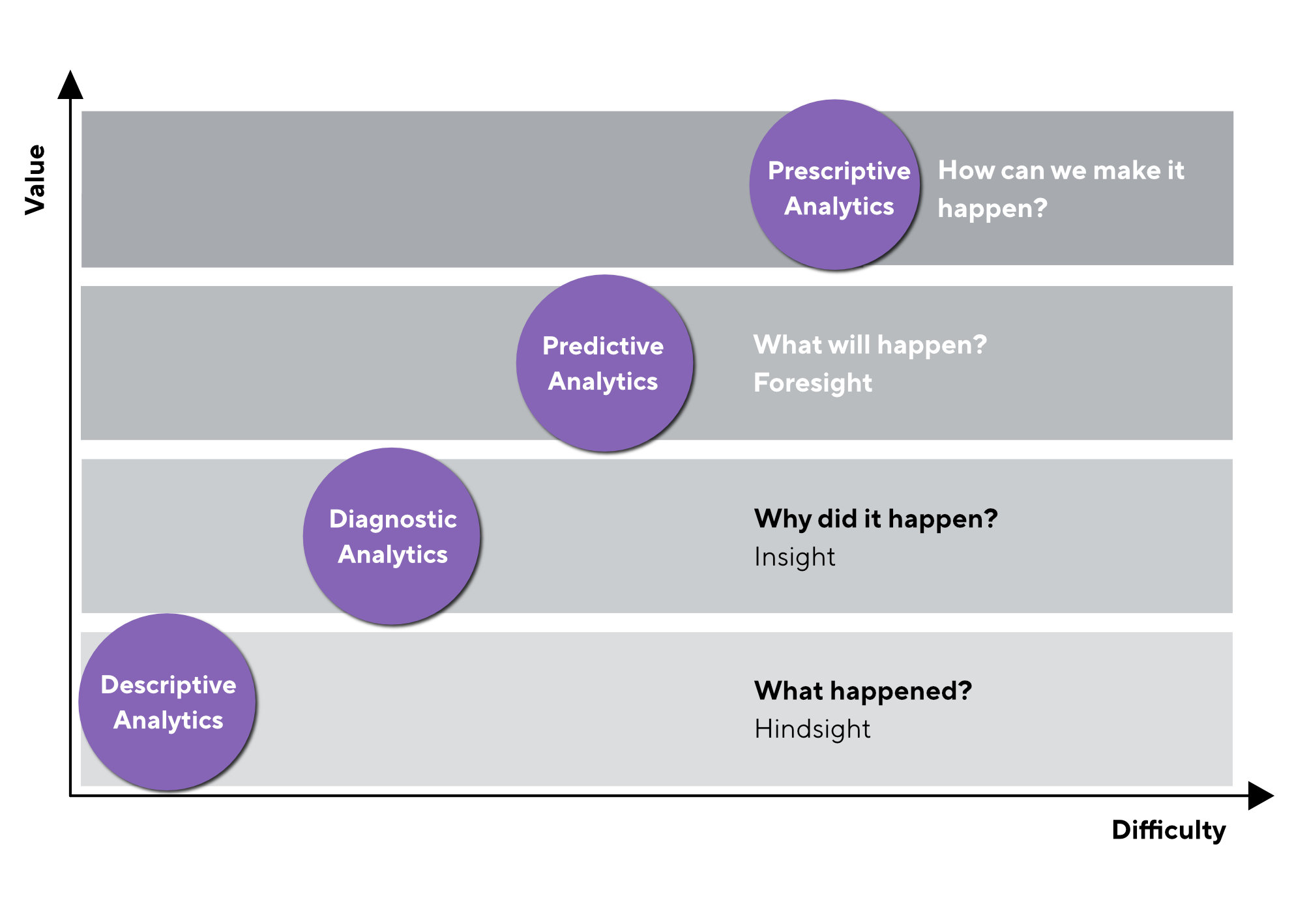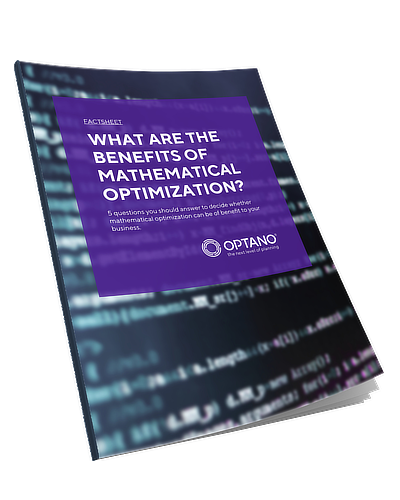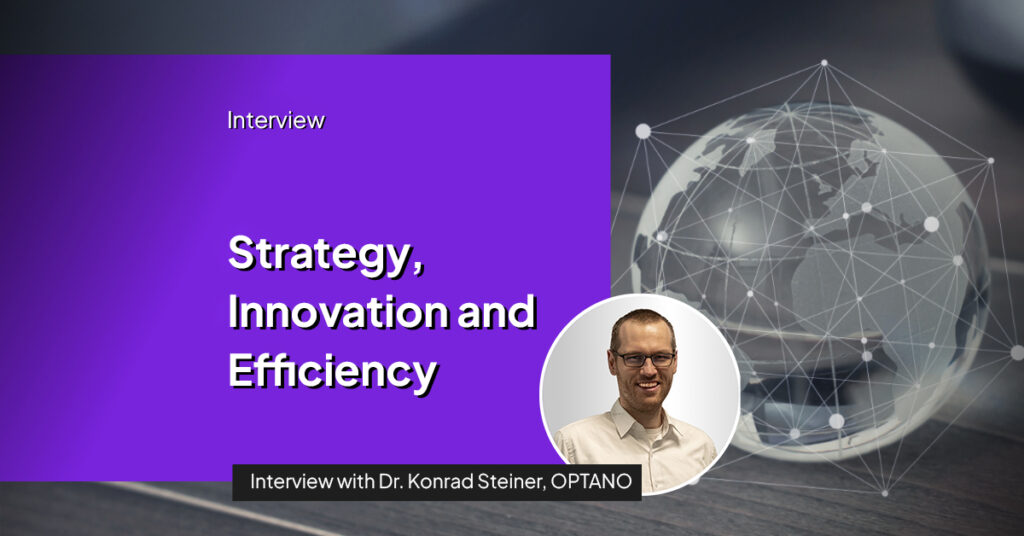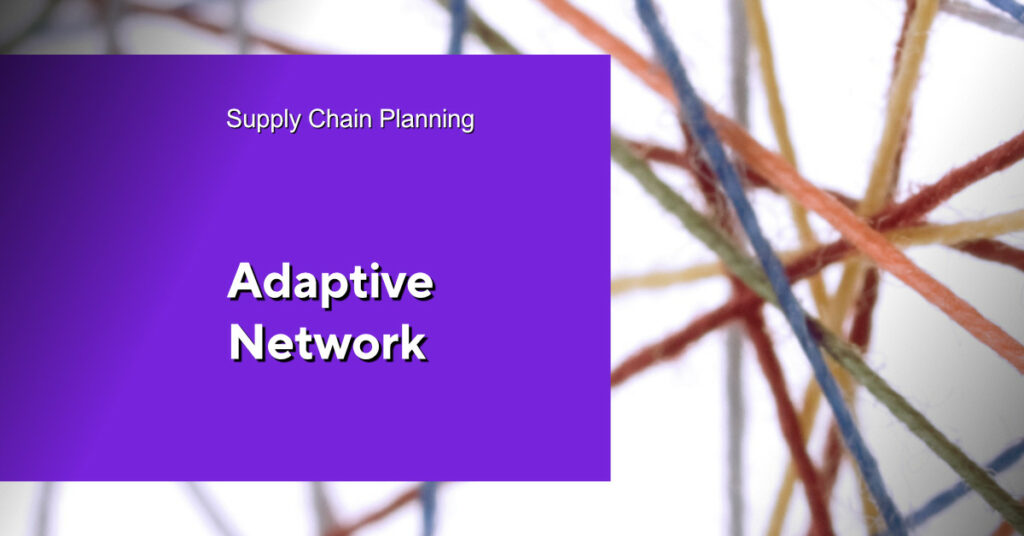Are you ready for Prescriptive Analytics?
While resources are becoming increasingly scarcer in many sectors, the amount of data is growing every day. However, if this data is applied correctly, its value will increase. A logical result of this is the investment in data management, especially in business analytics. Are you considering whether it is time for your business to press ahead with the use of analytics? Read on to learn more about the added value of your data by deploying Prescriptive Analytics.
Business Analytics – for fast and sound decisions
Structured and unstructured data from both internal and external sources form the basis for analytics technology. Data is extracted from systems such as ERP or CRM, but also from other sources, e.g. meteorological data, and then it is analyzed. In this way, you obtain a detailed overall picture of your company’s processes. This makes strategic planning easier and more certain. In addition, resources and individual processes can be planned better. One example here is the optimization of supply chains: where should production sites and warehouses be located or where should our suppliers be based? These are aspects which can be optimally planned on a long-term basis. The best route planning can be created at short notice. The objective of business analytics is to extract valuable information from available data and use the results of the analysis to make better optimization decisions.
Gartner’s Analytics Maturity Model
The Gartner maturity model is used to distinguish between four essential analytics stages. The complexity of the analytics as well as the value of the results increases with each development stage.

Gartner’s Analytics Maturity Model begins with Descriptive Analytics (“What happened?”), followed by Diagnostic Analytics (why did it happen?”). Predictive Analytics, as the name implies, focuses on the questions: “What will happen?”, “How can the best result be achieved?” or “Which measures should be taken?” and is the preliminary stage of Prescriptive Analytics. This is – as the supreme discipline, so to speak – the highest level of the model and answers the question: “How can the optimal result be achieved?” or “Which measures should be taken?”
You can learn more about analytics in our article Prescriptive Analytics in Production Planning where you can also download our factsheet “Business Analytics by Gartner”.

Are you interested in our factsheet?
What are the benefits of mathematical optimization?
Optimal decisions by applying Prescriptive Analytics
Many businesses are already using Predictive Analytics to make forecasts. With regard to the question “what will happen?”, when deploying Predictive Analytics, models are built from historical data and used to predict unknown events or changes in the future. For example, market trends or disruptive changes in specific sectors can be identified early on.
Prescriptive Analytics, however, goes even further. By applying various technologies (e.g. mathematical algorithms, simulation, Machine Learning and Artificial Intelligence) it analyzes a number of scenarios to come up with the best recommendation on which action should be taken next. By deploying Prescriptive Analytics, you not only obtain optimized resource planning and the resulting cost savings. It also provides a strategic competitive advantage – above all to data-driven companies.
More interesting articles

Dr. Konrad Steiner, the new Managing Director of OPTANO, is focused on sustainable growth, international expansion, and an “AI-first” transformation. With expertise in OR, consulting, and AI leadership, he brings valuable strategies to the table. Read how he is leading OPTANO into the future!
From machine scheduling to energy planning
Production planning as well as supply chain optimization are typical examples of areas in which Prescriptive Analytics can be deployed. Here the right products have to be manufactured and supplied at the right time. Apart from the above-mentioned possibilities, there are many more areas in which Prescriptive Analytics can be deployed: pricing, inventory management, technology management, financial planning, personnel planning…
The list can go on and on. We would like to use a specific example to highlight the vital role of Prescriptive Analytics in planning optimization. Energy management is currently a hot topic in view of the necessary transition to alternative energy sources.
Let’s digress…:
Prescriptive Analytics for the transition to alternative energy sources
One issue which is gaining more and more significance is “sustainable energy”. For this reason it is only logical that Prescriptive Analytics has a huge role to play in the transition towards alternative energy sources. The increasing use of renewable energy is leading to growing complexity in energy management as well as to volatile energy flows. Whereas you “only” had to plan the logistics for coal, gas and oil in the past, today you also have to consider new sites for wind, solar and hydropower which are being built every day. Not only that, due to weather conditions or the time of year and day, renewable energy cannot always guarantee a steady supply of energy. This means that the energy generated has to be stored temporarily. Energy providers are therefore compelled to make strategic decisions more frequently in order to guarantee system stability in the future and avoid supply shortfalls (you can learn more about system stability in the power supply in our article: Optimal contingency plans in any event).
The entire energy supply chain contains a vast amount of information. Among others, meteorological and climate data as well as consumption parameters are included in energy providers’ calculations, on the basis of which sound recommendations for energy management can be made. For example, energy requirements based on consumers’ behavioral patterns can be forecast. Based on this information, the required supply of wind, solar and hydropower can be regulated precisely. Risks such as electricity shortages can be avoided and the costs resulting thereof can be reduced. Combined with ambitious international climate goals, Prescriptive Analytics will become an indispensable factor in the transition to alternative energy sources.
Is Prescriptive Analytics right for your business?
The advantages of Prescriptive Analytics are evident. You can determine quite easily whether or not it is time for your business to deploy Prescriptive Analytics to optimize your planning. How? Well, if you answer one of the following questions with “yes”, then it is time to start thinking about deploying Prescriptive Analytics.
- Do you often find that you cannot determine which decisions are the best ones for your company?
- Do your decision-making systems make it diffcult or even impossible to consider constraints and changes at short notice?
- Is the number of variables in your planning processes so high that it is impossible to take them all into account?
How to achieve the best result – the 5 steps of a Prescriptive Analytics project with OPTANO
Although each project calls for a different procedure, an optimization project with OPTANO usually consists of the following five steps:
Step 1: Describing the project
The fundament of any optimization project is to identify the potential for improvement within your planning. What do you want to achieve with the improvement? Define the objectives of your project! This is where we can help.
Step 2: Defining business processes
Data modeling requires a detailed description of your business processes. This includes, among others, a defintion of the objectives, the variables and the constraints which need to be considered in the analysis. We help you to identify and define the business processes to be modelled.
Step 3: Building, validating and testing the model
In the next step we build the model which describes your problem. The validation is performed to ensure that the results are presented correctly. In addition, we test the model thoroughly to make sure that the optimization runs error-free.
Step 4: Preparing and incorporating the data
Structured and unstructured data from internal and external sources form the basis of any optimization. This means that all the data which has an influence on decision-making processes will be included in the analysis. Your data will be checked and, if necessary, prepared for plausibility and entered into the database. The same applies to your objectives because only then can you be sure that you will have the optimal plan to meet your business objectives.
Step 5: Implementing mathematical optimization
As soon as the Prescriptive Analytics model has been built, it can be used for data-driven optimization. Depending on your objectives the target plan will be calculated in different optimization scenarios. You will then obtain guidelines and the possibility to automate your decision-making.
Expertise and iteration for best results
The entire process is very iterative and calls for good collaboration and communication between analysts and experts from the specialized departments. OPTANO provides first-rate expertise in all areas throughout the entire process: from identifying the required data to building and validating the optimization model right down to implementation.
To sum up…
In times of increasing competitive pressure, companies need to exploit the progress in analytics – in particular Prescriptive Analytics – and thus benefit from sound recommendations within proactive decision-making. Analytics as such will develop continuously. However, it needs the support of Machine Learning and Artificial Intelligence. These different technologies have a positive influence on one another and drive forward the digitalization of businesses.
Do you already know our factsheet on this topic?

In our factsheet “What are the benefits of mathematical optimization?” we ask 5 questions to help you assess whether mathematical optimization brings benefits to your organization.
To obtain our factsheet, all you need to do is enter your contact details in the space below. A pop-up window will then open to download the whitepaper. Please note that by providing us with your email address, you agree that we may contact you on this topic. You may revoke this agreement at any time by contacting privacy@optano.com.





